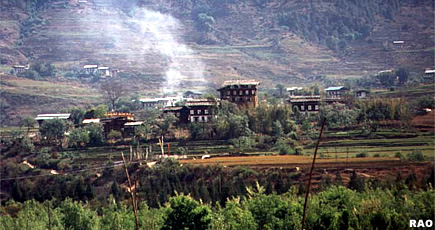 |
Bhutan's
Economy |
|
 |
Bhutan Information |
|
|
 |
|
Bhutan's
Migration Problem Declining farm labour
|
 |
Bhutan
has 7,63,156 acres (LUPP - 1995) or 7.7 percent of the total land area
under cultivation. The problem - there are simply not enough hands to keep
fields ploughing and crops growing in this frugal parcel of cultivable
land.
A
recent survey of the five west and central dzongkhags - Gasa, Punakha,
Wangdue, Tsirang, and Dagana - reveals that there is a marked decline in
the availability of farm labour. Agriculturists describe this decline as
a serious "drawback" to agricultural development.
|
|
|
According
to the report, there is a glaring "mismatch between household labour availability
and requirement".
For
example the mean total residenthousehold members is 5.8 of which the mean
total full time labour is 3. On the other hand, the mean total labour requirement
is 4.27. Of the 298 households interviewed during the survey, 50 percent
reported a "decrease" in labour availability over the years, 26 percent
reported "thesame", and 24 percent reported "increased". "We are quite
surprised with the findings.
We
initially assumed that only villages near urban settlements would have
been affected. But the survey reveals that even far-flung and interior
regions are affected by this problem," says the project director of the
RNRRC in Bajo, Sangay Duba. This is essentially because farm household
labour availability has become dependent on "the walking distance from
the road point". It has been observed that labour availability decreases
with an increase in the time of the walking distance.
|
Migration
from the villages as a dominant factor resulting in the shortage of farm
labour
|
The
survey report also attributes migration from the villages as a dominant
factor resulting in the shortage of farm labour. "Students leave their
villages after completing their studies. Many people have already joined
the armed forces, the government, or some services.Others have become monks
and anims. Only old people remain in the villages," says the RNR extension
agent in Khaling, Nima Weezer.
Survey
findings reveal that farm labour scarcity has had a negative impact on
farming operations and agricultural development. There has been areduction
in the area of cultivation, food production has become restricted to subsistence,
livestock population has decreased, and agricultural work isnever completed
on time. Other alarming developments such as increase in the cost of farming,
low crop yield, insufficient food, and change of farming practices are
also observed with increasing frequency. These new developments have not
only seriously challenged the ministry of agriculture"s guiding principle
of "efficient and sustainable use of naturalresources", but has also put
the cherished goal of attaining food self-sufficiency in jeopardy.
While
the government recognizes the dwindling farm labour as "one of the biggest
constraints", many feel that a lot remains to be done to solve the problem.
Strategies adopted by the ministry of agriculture to alleviate farm labour
shortage have been difficult to execute. Government officials themselves
complain of the "lack of inter-sectoral coordination" in efforts to curtail
the problem.
Relevant
government agencies have as yet not been able to come up with a reliable
"documented information and hard data" on farm labour shortage. "For proper
economic planning and growth, we need basic information and data. But this
need is not fully appreciated in some sectors of thegovernment," says the
head of the policy and planning division in the ministry of agriculture,
Dr. Pema Gyamtsho. He, however, mentions that the ministry of agriculture
realizes the "seriousness of farm labour shortage" and is fully committed
towards solving theproblem. "We have already put in place a number of measures
such as construction of rural access roads, farm mechanization, and special
trainingpackages on farm businesses for school-leavers," he says.
The
survey report mentions a number of valuable recommendations suggested by
farmers of which two are seen as being of "crucial importance".
The
first is the need "to improve rural areas by improving the standard of
living and quality of village lives" to discourage rural-urban migration.
The
second is "to make farming more profitable by introducing appropriate and
economically efficient agricultural technologies and improving the marketand
marketing system in the country".
During
the survey, households were categorized as "good", "medium", and "poor".
"The farmers actually categorized themselves depending on their "chodub"
ability to carry out livelihood activities," says Sangay Duba. "The idea
of categorizing the farmers is essentially to see which categoryis the
most affected," he says.
The
questionnaire for the survey covered areas such as household location and
land use, livestock number, availability of hired labour, seriousness andimpact
of the labour shortage problem, and farmer"s strategies to overcome the
problem. The survey carried out by the RNRRC in Bajo was the first major
step taken to gauge and analyze the severity and the extent of the shortage
of farmlabour in the country. Livestock, field crops, farming system, and
forestry research assistants from the RNR sector conducted the survey.
| This
article was contributed by KUENSEL, Bhutan's National Newspaper |
 |
|


